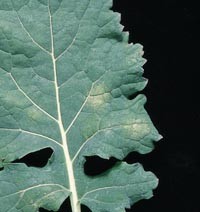Light leaf spot leaves its mark in the south

Oilseed rape light leaf spot varietal resistance is a critical factor for growers to consider this season, and not just in the north.
HGCA trials suggest that fungicides only give up to 50% control of the disease, which last season was found just about everywhere, according to Crop Monitor observations.
And the black blotches being found on oilseed rape stubbles are next year’s light leaf spot inoculum, says Peter Gladders of ADAS.
The only oilseed rape disease which showed an increase in prevalence compared with the previous season, light leaf spot has continued its spread to areas previously unaffected by the disease, he adds.
“Crop Monitor results confirm that 2010 was the second highest year on record for light leaf spot, with 71% of crops affected,” he reports. “It’s the fifth year in succession that it has increased.”
Although the north was the region with the highest incidence, with 90.5% of crops affected, the disease is now causing serious problems further south for two reasons, believes Dr Gladders.
“The fungicides used for control aren’t doing an adequate job, even where two spray programmes are being used, and the varieties being grown don’t have good light leaf spot resistance.”
That’s in marked contrast to the varieties used in the north of England and Scotland, many of which are chosen for their good resistance to the disease, he points out. “It may be time for growers who’ve had problems to look at the benefits of growing varieties such as Cuillin and Catana in other regions.”
These varieties will still get some light leaf spot, he notes, but adds that less yield is put at risk when they are included.
“The situation is serious. There was a great deal of light leaf spot in crops this year – it has overtaken phoma as the number one disease. Warning bells should be ringing as levels have been rising steadily.”
Although light leaf spot doesn’t like hot summers, the fungus survives on the debris from the previous oilseed rape crop, he explains. After the initial infection in the autumn, the disease spreads by rainsplash-dispersed spores.
“It likes a cold winter and can keep growing when the plants have stopped. Left unchecked, it can reduce yields by 1.5t/ha, although that’s still fairly unusual.”
As symptoms are easy to confuse with fertiliser scorch, growers should incubate leaves in plastic bags left in a warm place for three days if they are uncertain, suggests Dr Gladders.
“That will help with diagnosis and allow them to treat crops when 25% of plants are infected.”
But fungicides only give 30-50% control, he says. Trials indicate that prothioconazole-based sprays are the most effective, although tebuconazole and flusilazole will also give some control and shouldn’t be dismissed.
Lincolnshire Farmacy agronomist Richard Hartley says that an autumn light leaf spot spray is now a routine treatment for most of his clients, but admits that it wasn’t considered necessary a few years ago.
“The disease has been there, at varying levels, in recent years,” he says. “An autumn spray is needed now – you can’t hope to just clean up any infection in the spring.”
The annual preliminary light leaf spot forecast will be issued in September or October by Rothamsted Research.
The crop and region specific forecast is based on the incidence of previous season pod disease, as well as summer temperature and winter rainfall data.
A final forecast is then produced in March, which includes the deviation of winter rainfall data.
[Panel]
ADAS and Frontier trials results suggest that varietal resistance is the key to controlling light leaf spot.
Fungicide trials at ADAS High Mowthorpe found Cuillin gave a 0.65t/ha yield advantage over Krypton and Castille.
“The old rule of thumb was that each additional point in terms of a variety’s resistance rating was worth £10/t. But based on this data and today’s rape prices, each point is currently worth 0.2t/ha or £50-60/ha,” Dr Gladders says.
But don’t dismiss the importance of fungicides, he stresses, even though in HGCA trials the best performance is now just 50% control.
“Cuillin will need good phoma control in the autumn, and does benefit from a light leaf spot follow-up in the spring. This season, a March-applied Proline gave a 0.2t/ha response in the variety.”
Frontier trials in the north of England also found higher yields from Cuillin than varieties with a lower light leaf spot resistance, says the firm’s Jim Carswell.
Untreated Cuillin yielded 4.59t/ha and produced comparative gross output figures 16 and 8% ahead of untreated Castille and Catana respectively.
However, when given the benefit of a comprehensive fungicide programme, Cuillin gave a gross output of 126%.
Catana, rated 8 for light leaf spot resistance, was not far behind on 115% and Krypton at 114%. But Castille, rated 5 for LLS, suffered from a low oil content at just 106%.
Mr Carswell says the figures back up Cuillin’s HGCA recommendation and reputation as a key variety for northern Britain, where light leaf spot is a major disease.
“Its strong inherent light leaf spot rating should provide greater flexibility in spray date and rate selection,” he suggests.
“We need to do all we can to cut disease risks and selecting a variety with the best inherent resistance ratings is a good starting point,” he concludes.

